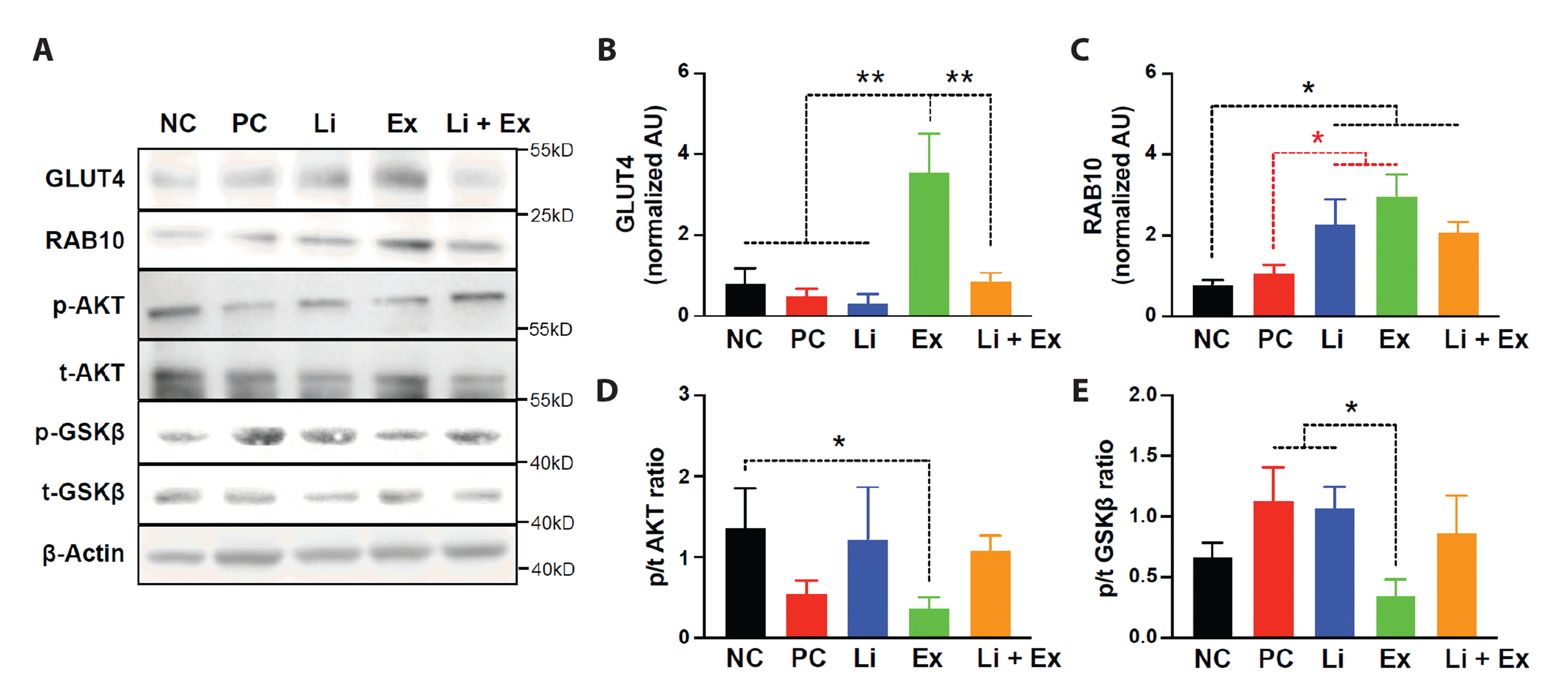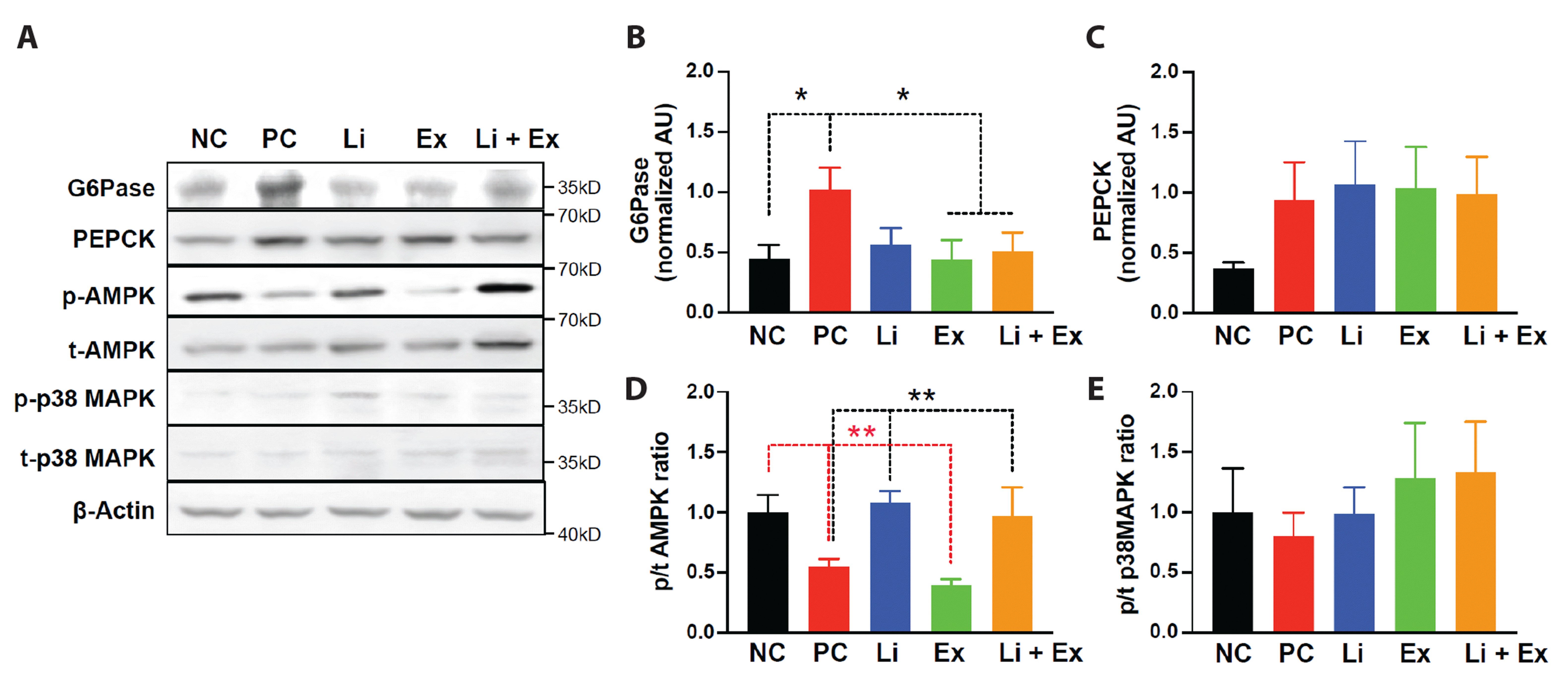2. Jung S, Koh J, Kim S, Kim K. 2017; Effect of lithium on the mechanism of glucose transport in skeletal muscles. J Nutr Sci Vitaminol (Tokyo). 63:365–371. DOI:
10.3177/jnsv.63.365. PMID:
29332897.
3. Jung SR, Park SY, Koh JH, Kim JY. 2021; Lithium enhances exercise-induced glycogen breakdown and insulin-induced AKT activation to facilitate glucose uptake in rodent skeletal muscle. Pflugers Arch. 473:673–682. DOI:
10.1007/s00424-021-02543-0. PMID:
33660027. PMCID:
PMC8049887.
4. Haugaard ES, Mickel RA, Haugaard N. 1974; Actions of lithium ions and insulin on glucose utilization, glycogen synthesis and glycogen synthase in the isolated rat diaphragm. Biochem Pharmacol. 23:1675–1685. DOI:
10.1016/0006-2952(74)90394-3. PMID:
4210202.
6. Wu KK, Huan Y. 2008; Streptozotocin-induced diabetic models in mice and rats. Curr Protoc Pharmacol. Chapter 5:Unit 5.47.
8. Khan A, Jamwal S, Bijjem KR, Prakash A, Kumar P. 2015; Neuroprotective effect of hemeoxygenase-1/glycogen synthase kinase-3β modulators in 3-nitropropionic acid-induced neurotoxicity in rats. Neuroscience. 287:66–77. DOI:
10.1016/j.neuroscience.2014.12.018. PMID:
25536048.
9. Wong RK, Boedeker B, Hickey TM, Wilkinson DS, Johnson LF. 1984; Lithium chloride: protective and antisecretory properties in rats. Gastroenterology. 87:362–371. DOI:
10.1016/0016-5085(84)90714-5. PMID:
6329891.
10. Tondo L, Alda M, Bauer M, Bergink V, Grof P, Hajek T, Lewitka U, Licht RW, Manchia M, Müller-Oerlinghausen B, Nielsen RE, Selo M, Simhandl C, Baldessarini RJ. International Group for Studies of Lithium (IGSLi). 2019; Clinical use of lithium salts: guide for users and prescribers. Int J Bipolar Disord. 7:16. DOI:
10.1186/s40345-019-0151-2. PMID:
31328245. PMCID:
PMC6643006. PMID:
e54f612fb1eb4a14a401451e39964215.
11. Grandjean EM, Aubry JM. 2009; Lithium: updated human knowledge using an evidence-based approach: part III: clinical safety. CNS Drugs. 23:397–418. DOI:
10.2165/00023210-200923050-00004. PMID:
19453201.
12. Wang N, Liu Y, Ma Y, Wen D. 2017; High-intensity interval versus moderate-intensity continuous training: Superior metabolic benefits in diet-induced obesity mice. Life Sci. 191:122–131. DOI:
10.1016/j.lfs.2017.08.023. PMID:
28843495.
13. Kemi OJ, Loennechen JP, Wisløff U, Ellingsen Ø. 2002; Intensity-controlled treadmill running in mice: cardiac and skeletal muscle hypertrophy. J Appl Physiol (1985). 93:1301–1309. DOI:
10.1152/japplphysiol.00231.2002. PMID:
12235029.
14. McQuin C, Goodman A, Chernyshev V, Kamentsky L, Cimini BA, Karhohs KW, Doan M, Ding L, Rafelski SM, Thirstrup D, Wiegraebe W, Singh S, Becker T, Caicedo JC, Carpenter AE. 2018; CellProfiler 3.0: next-generation image processing for biology. PLoS Biol. 16:e2005970. DOI:
10.1371/journal.pbio.2005970. PMID:
29969450. PMCID:
PMC6029841. PMID:
858648fc1f0a434e88a1227131207d19.
16. Hsu FL, Huang CF, Chen YW, Yen YP, Wu CT, Uang BJ, Yang RS, Liu SH. 2013; Antidiabetic effects of pterosin A, a small-molecular-weight natural product, on diabetic mouse models. Diabetes. 62:628–638. DOI:
10.2337/db12-0585. PMID:
23069626. PMCID:
PMC3554375.
17. Ko JR, Seo DY, Park SH, Kwak HB, Kim M, Ko KS, Rhee BD, Han J. 2018; Aerobic exercise training decreases cereblon and increases AMPK signaling in the skeletal muscle of STZ-induced diabetic rats. Biochem Biophys Res Commun. 501:448–453. DOI:
10.1016/j.bbrc.2018.05.009. PMID:
29730289.
19. Jiang SJ, Dong H, Li JB, Xu LJ, Zou X, Wang KF, Lu FE, Yi P. 2015; Berberine inhibits hepatic gluconeogenesis via the LKB1-AMPK-TORC2 signaling pathway in streptozotocin-induced diabetic rats. World J Gastroenterol. 21:7777–7785. DOI:
10.3748/wjg.v21.i25.7777. PMID:
26167077. PMCID:
PMC4491964.
22. Hawley SA, Davison M, Woods A, Davies SP, Beri RK, Carling D, Hardie DG. 1996; Characterization of the AMP-activated protein kinase kinase from rat liver and identification of threonine 172 as the major site at which it phosphorylates AMP-activated protein kinase. J Biol Chem. 271:27879–27887. DOI:
10.1074/jbc.271.44.27879. PMID:
8910387.
23. Hawley SA, Pan DA, Mustard KJ, Ross L, Bain J, Edelman AM, Frenguelli BG, Hardie DG. 2005; Calmodulin-dependent protein kinase kinase-beta is an alternative upstream kinase for AMP-activated protein kinase. Cell Metab. 2:9–19. DOI:
10.1016/j.cmet.2005.05.009. PMID:
16054095.
24. Herrero-Martín G, Høyer-Hansen M, García-García C, Fumarola C, Farkas T, López-Rivas A, Jäättelä M. 2009; TAK1 activates AMPK-dependent cytoprotective autophagy in TRAIL-treated epithelial cells. EMBO J. 28:677–685. Erratum in:
EMBO J. 2009;28:1532. DOI:
10.1038/emboj.2009.8. PMID:
19197243. PMCID:
PMC2666037.
25. Lee J, Sun C, Zhou Y, Lee J, Gokalp D, Herrema H, Park SW, Davis RJ, Ozcan U. 2011; p38 MAPK-mediated regulation of Xbp1s is crucial for glucose homeostasis. Nat Med. 17:1251–1260. DOI:
10.1038/nm.2449. PMID:
21892182. PMCID:
PMC4397266.
26. Bosch F, Rodriguez-Gil JE, Hatzoglou M, Gomez-Foix AM, Hanson RW. 1992; Lithium inhibits hepatic gluconeogenesis and phosphoenolpyruvate carboxykinase gene expression. J Biol Chem. 267:2888–2893. DOI:
10.1016/S0021-9258(19)50669-X. PMID:
1371108.
27. Bao H, Zhang Q, Liu X, Song Y, Li X, Wang Z, Li C, Peng A, Gong R. 2019; Lithium targeting of AMPK protects against cisplatin-induced acute kidney injury by enhancing autophagy in renal proximal tubular epithelial cells. FASEB J. 33:14370–14381. DOI:
10.1096/fj.201901712R. PMID:
31661633.
28. Feng AL, Xiang YY, Gui L, Kaltsidis G, Feng Q, Lu WY. 2017; Paracrine GABA and insulin regulate pancreatic alpha cell proliferation in a mouse model of type 1 diabetes. Diabetologia. 60:1033–1042. DOI:
10.1007/s00125-017-4239-x. PMID:
28280900.
29. Takeda Y, Fujita Y, Honjo J, Yanagimachi T, Sakagami H, Takiyama Y, Makino Y, Abiko A, Kieffer TJ, Haneda M. 2012; Reduction of both beta cell death and alpha cell proliferation by dipeptidyl peptidase-4 inhibition in a streptozotocin-induced model of diabetes in mice. Diabetologia. 55:404–412. DOI:
10.1007/s00125-011-2365-4. PMID:
22072158.
31. Malhi GS, Tanious M, Das P, Coulston CM, Berk M. 2013; Potential mechanisms of action of lithium in bipolar disorder. Current understanding. CNS Drugs. 27:135–153. DOI:
10.1007/s40263-013-0039-0. PMID:
23371914.
32. Sinaei M, Alaei H, Nazem F, Kargarfard M, Feizi A, Talebi A, Esmaeili A, Nobari H, Pérez-Gómez J. 2021; Endurance exercise improves avoidance learning and spatial memory, through changes in genes of GABA and relaxin-3, in rats. Biochem Biophys Res Commun. 566:204–210. DOI:
10.1016/j.bbrc.2021.05.080. PMID:
34214757.
34. Rinaman L. 1999; A functional role for central glucagon-like peptide-1 receptors in lithium chloride-induced anorexia. Am J Physiol. 277:R1537–R1540. DOI:
10.1152/ajpregu.1999.277.5.R1537. PMID:
10564228.
35. Hamasaki H. 2018; Exercise and glucagon-like peptide-1: does exercise potentiate the effect of treatment? World J Diabetes. 9:138–140. DOI:
10.4239/wjd.v9.i8.138. PMID:
30147850. PMCID:
PMC6107470.




 PDF
PDF Citation
Citation Print
Print






 XML Download
XML Download